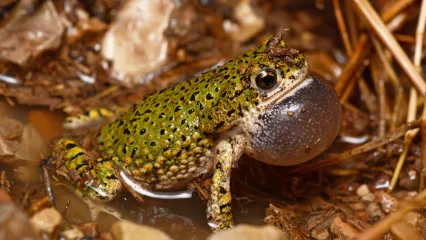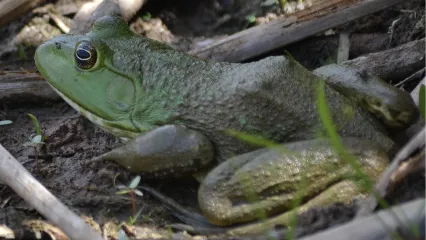
Description
The Chihuahuan green toad is a small, relatively flat-bodied toad. Its ground color is light green to greenish-yellow, overlain with black spots. In Oklahoma and the eastern part of its range, the black spots are small and distinct, or connected to form small circles. In western areas, the black spots are connected to form a reticulated pattern. The head and back of this toad are very warty. Unlike many other toads, this species does not have cranial crests. Breeding males have a black or dark gray throat, whereas females have a white throat. The belly is mostly white, although the pelvic patch (lower belly) is pinkish-white. Toads are able to withstand dry conditions because water is easily taken up through the porous patch by pressing it to damp soil.
Although most toad tadpoles are black, tadpoles of Chihuahuan green toads are somewhat transparent and are mottled gray or greenish-gray. They also differ from other tadpoles in having 2/2 tooth rows. They spend about two to four weeks in the water before transforming into froglets. Size at metamorphosis is about 1 inch.
Size
Females are larger than males. Males are about 1.5 to 1.7 inches in length, whereas females are 1.7 to 2 inches.
Habitat
The Chihuahuan green toad has a relatively restricted distribution occurring only in the southwestern counties and in Cimarron County in Oklahoma. Outside of Oklahoma, it occurs from central Texas to the southern half of New Mexico. The range narrows to the north, extending in a band through the Texas Panhandle and Cimarron County, Oklahoma, to southeast Colorado and a few counties in western Kansas. It occurs in northern Mexico to Zacatecas and San Luis Potosi.
Life Cycle
These toads occur in open, fairly arid habitats. In eastern areas, including Oklahoma, they occur in shortgrass to mixed-grass prairies, typically with some relief, whereas further west they can be found in various types of grasslands, mesquite savannas, or lower desert grasslands. Breeding occurs from March to the end of summer, depending on location and weather conditions. Breeding is initiated by heavy rainfall. If rains are not sufficient, these toads may not breed until the following year. Breeding choruses are found around temporary pools, roadside ditches, or pools in small intermittent streams. The eggs are produced in short strings that are attached to the stems and leaves of submerged aquatic vegetation. Some observers have reported that eggs are laid singly. Clutch size is dependent on female size but is typically about 1,200 eggs.
How To Observe
Chihuahuan green toads are difficult to observe. They are nocturnal and are rarely active above ground unless migrating to a breeding chorus or breeding. When inactive, they take refuge under rocks or in burrows. During summer, they can be found by day beneath rocks or other cover objects.
Males call from the shoreline or in shallow water of ponds, ditches, or small backwater pools in streams. The call is a short, buzzing trill, which is somewhat insect-like.
(This profile was created by Dr. Laurie Vitt as part of a partnership between the Wildlife Department and the Sam Noble Oklahoma Museum of Natural History. It was funded as part of a larger grant to survey and inventory amphibians and reptiles of the Wildlife Management Areas of Oklahoma: T-35-P-1.)


